
Trivia!
In Olympia lingo, what is an “X file?”
Highlights of Week One
In a mostly virtual format, the Legislature kicked off its 60-day legislative session Monday. They wasted no time getting down to bill hearings and work sessions. However, the traditional “first day of school” vibes were not felt given nearly all lawmakers, staff and lobbyists were working remotely.
Tuesday, Governor Inslee provided his State of the State address in an empty State Reception Room rather than to a joint session of the Legislature. In his remarks, Governor Inslee urged lawmakers to focus on the urgent crises facing the state, including housing, transportation, the needs of our students and poverty reduction.
Fiscal Committee Hearings. Early in the week, the budget committees held public hearings where more than 100 interested parties in each hearing urged budget writers to include their top issue (fully funded of course) in the final adopted supplemental budget. Testifiers were limited to one minute and, even with that limitation, both hearings ran over two and a half hours. Throughout both hearings, a common theme was around stress within the workforce, particularly in the health and human services arena. Low compensation and fatigue – fatigue exacerbated by nearly two years of a pandemic – were discussed frequently.
In both hearings, David Schumacher, the Governor’s Budget Director, provided an overview of Governor Inslee’s proposed $62 billion budget. Schumacher stressed that with the many urgent needs facing the state, this is not a typical supplemental budget in that it proposes a number of significant investments when most supplemental budgets include tweaks and minor increases. Schumacher cited increased federal funding (most of which is one-time), continued growth in state revenue, declining caseloads in some areas as well as continued uncertainty with the pandemic as factors that influenced budget decisions.
Legislative budget writers will weigh the Governor’s proposal, the testimony received, individual legislative requests and more up-to-date revenue numbers that will come out mid-February and work to craft a final budget before Sine Die March 10.
Work Sessions. Often in the first week or two of the legislative session, committees will hold “work sessions.” In these work sessions, speakers are invited to educate committee members on various issues instead of advocating for the passage of specific bills.
Wednesday, the House Children, Youth and Families Committee held a work session on Fair Start for Kids Act implementation. Nicole Rose, Assistant Secretary for Early Learning and Allison Krutsinger, Director of the Office of Government Affairs and Community Engagement presented for DCYF. They spoke from this PowerPoint which includes a lot of rich data and information. Following are some highlights:
- As of Dec. 31, 2021, nearly $260 million in child care stabilization grants were awarded to 4,319 providers.
- For the state Fiscal Year 2022 ECEAP expansion, DCYF received applications for 1,358 slots.
- For the Early Learning Facilities grant program, more than 140 applicants requested $73 million for projects. Only $22 million in funding was available.
- For home visiting expansion, 7 programs received funding to serve 185 more families with applications for expansion far exceeding available funding.
Following the DCYF presentation, DeeAnn Puffert, CEO of Child Care Aware, updated the committee on implementation from Child Care Aware’s unique perspective as the operator of the statewide call center. Puffert provided a number of examples of families positively impacted by the benefits of the Fair Start for Kids Act, highlighting one family’s joy and relief in learning their child care costs would be reduced by $18,000 a year with the reduction in co-payments.
Finally, the committee heard from two child care providers – Laura Murphey and Jennifer Kelty – who spoke of their on-the-ground experience as providers. They discussed the challenges of navigating providing child care with the uncertainty of COVID-19 and the need for continued investment to stabilize the industry.
Bills, Bills – and more Bills!
It has been a flurry with lawmakers introducing a lot of bills. I check the bill introductions each night and, although there are fewer early learning bills per se, there are a number of bills of interest. Visit Start Early Washington’s resources page to view the latest list of bills we are tracking.
It is important to note that not every bill introduced will receive a hearing, and there are many steps before a bill becomes a law. We will do our best to keep you updated on relevant bills.
Here are some bills that jumped out to me that are a little outside of traditional early learning, but related:
HB 1872 (Senn and Slatter). Establishes a care worker center with the purpose of elevating care sectors as a respected sector of the workforce, increasing retention and recruitment and promoting the value and different employment options of a care worker. The bill calls out three caregiving professions: child care, long-term care and personal care attendants for people with disabilities.
HB 1881 (Harris-Talley and Entenman). Creates a voluntary certification process for birth doulas. The bill specifies that doulas do not need to be certified to continue to practice. It also calls for the joint creation of competency-based requirements with community partners who advance equitable access to improve perinatal outcomes and care through holistic services for black and brown communities.
HB 1890 (Callan). Brings forward recommendations from the Children and Youth Behavioral Health Workgroup, including a call for the development of a strategic plan and inclusion of compensation of up to $200 a day for individuals with lived experience participating in the Children and Youth Behavioral Health Workgroup or its advisory bodies.
HB 1947 (Frame). Provides a monthly diaper subsidy for parents or caregivers of children under age 3 participating in the Temporary Assistance for Needy Families program.
SB 5793 (Wilson). Provides the ability for state boards, commissions, councils, committees and other similar groups to provide stipends for community members with lived experience engaging in such entities.
What’s Ahead?
With the first big cutoff quickly approaching Feb. 3 for bills to be voted out of policy committees, the next 2.5 weeks will focus on policy committee hearings.
Of the bills listed above, the following are scheduled for Public Hearings next week:
- HB 1872 is scheduled in the House College and Workforce Development Committee Jan. 19 at 8:00 a.m.
- HB 1890 is scheduled for a Public Hearing in the House Children, Youth and Families Committee Jan. 17 at 1:30 p.m. and for an Executive Session (vote) Jan. 20 at 10:00 a.m.
- HB 1947 will receive a Public Hearing Jan. 21 at 10:00 a.m. in the House Housing, Human Services and Veterans Committee.
- Finally, SB 5793 is scheduled for a Public Hearing in the Senate Government and Elections Committee on Jan. 19 at 8:00 a.m. and for an Executive Session (vote) Jan. 21 at 10:30 a.m.
In short, the next 2.5 weeks will involve a lot of watching TVW – and waiting for bills of interest to be heard.
How Can I Make My Voice Heard?
If you are interested in following a bill, you can sign up to receive email notifications. That option is on the right side of each bill information page. (I included the doula certification bill as an example). Once you sign up for notifications, you will be notified when there has been activity on the bill.
When a bill has been scheduled for a hearing, you can sign up to provide oral testimony, written testimony or make your position noted for the record. To do this, go to the committee sign-up page. You then identify which chamber the bill is to be heard and click down for the committee and date of the hearing. From there, you click on the agenda item and can sign up. The committee sign-up page also has detailed information.
Events to Promote Racial Equity Dialogues
As we approach the observance of Martin Luther King Jr. Day and the National Day of Racial Healing, here are just a couple opportunities to take action and reflect:
- Jan. 18, 12:00 p.m. – The W.K. Kellogg Foundation is hosting an annual observation of the National Day of Racial Healing. Join the conversation to share values and create a blueprint for healing from the effects of racism. “Launched on Jan. 17, 2017, it is an opportunity to bring ALL people together in their common humanity and inspire collective action to create a more just and equitable world.”
- Jan. 19, 6:00 – 7:30 p.m. – The United Way of King County is hosting a virtual conversation about advancing racial equity with the author of “How the Word is Passed: A Reckoning With the History of Slavery Across America,” Clint Smith and a dynamic panel of experts.
 Photo Credit: Erica Hallock
Photo Credit: Erica Hallock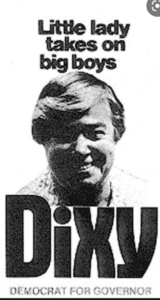 Dixy Lee Ray Campaign Poster (1976)
Dixy Lee Ray Campaign Poster (1976)

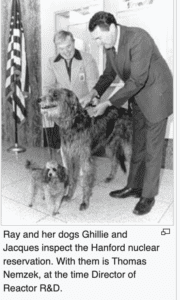 Dixy Ray and her dogs at the Hanford nuclear reservation
Dixy Ray and her dogs at the Hanford nuclear reservation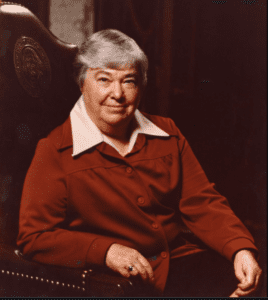 Official Gubernatorial Portrait of Governor Dixy Lee Ray
Official Gubernatorial Portrait of Governor Dixy Lee Ray
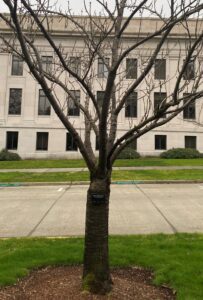



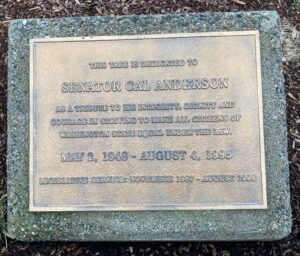



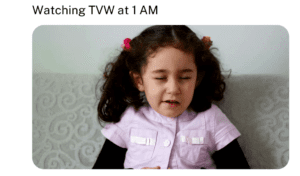
 Map of Washington Territory
Map of Washington Territory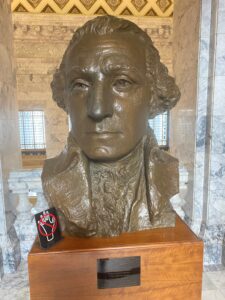 George Washington Bust
George Washington Bust



 Pickleball Founder (and former WA Lt. Governor) Joel Pritchard
Pickleball Founder (and former WA Lt. Governor) Joel Pritchard

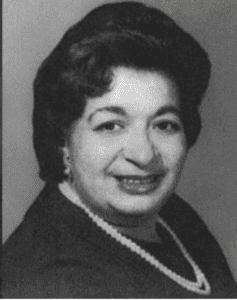
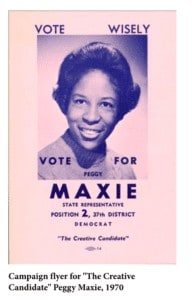
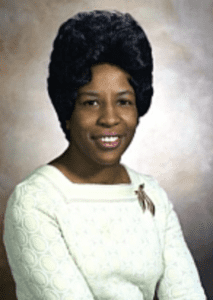


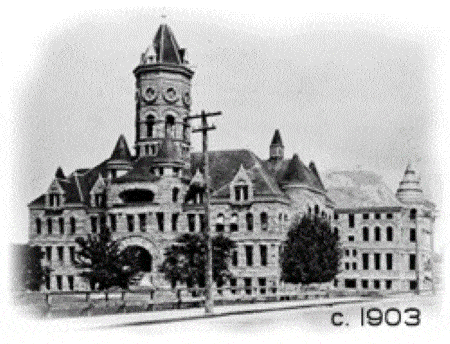
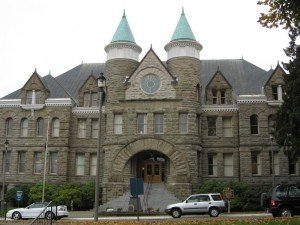

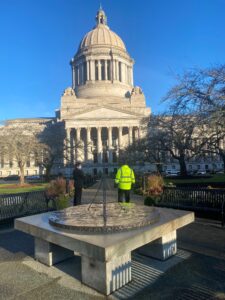

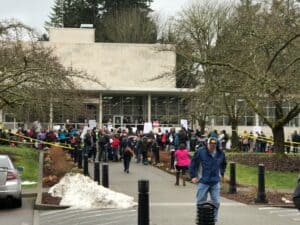

 Unfortunately, an “X file” at the Washington Capitol does not relate to the 1990s hit show “The X Files” – or have anything to do with aliens. Wouldn’t it be cool if it did?
Unfortunately, an “X file” at the Washington Capitol does not relate to the 1990s hit show “The X Files” – or have anything to do with aliens. Wouldn’t it be cool if it did?